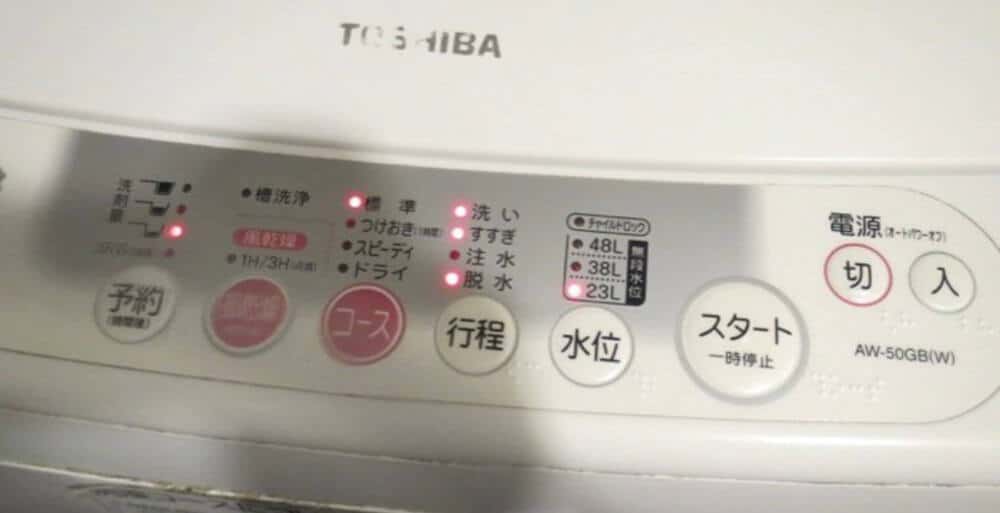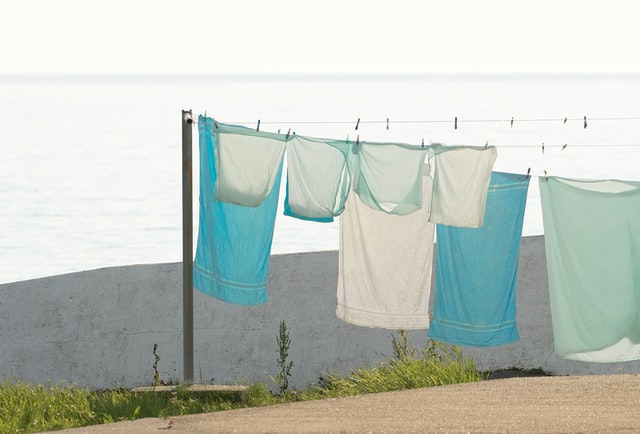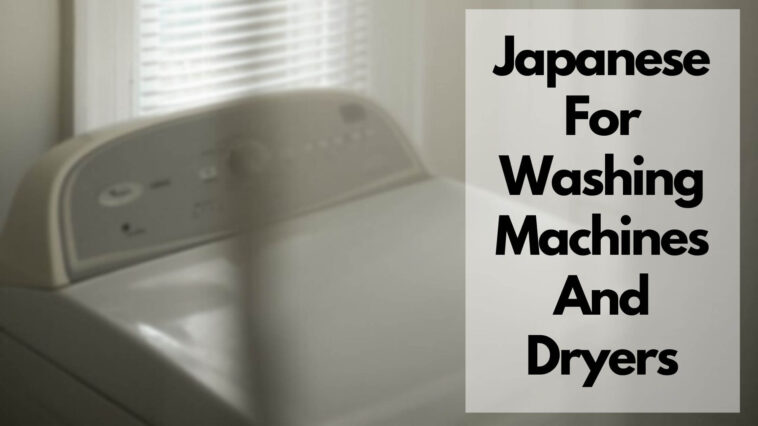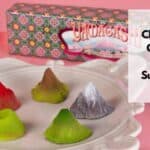Confused with all the kanji on your Japanese washing machine and dryer? Here’s a cheat sheet with Japanese for washing machines and dryers so nobody else has to help you with your dirty laundry!
In Japan, washing machines and dryers are essential household appliances designed with cutting-edge technology and innovative features. Known for their efficiency and compact designs, these appliances cater to Japan’s space-conscious living.
Let’s explore the world of Japanese washing machines and dryers, known for their quality and performance.
Page Contents
Japanese Symbols for Washing Machines and Dryers
Here’s a cheat sheet with Japanese for washing machines and dryers for quick reference:
Japanese Washing Machine Settings Symbols

Laundry Products
| Japanese | Rōmaji | English translation |
| 洗剤 | senzai | Detergent |
| 柔軟剤 | nyūnanzai | Fabric softener |
| 柔軟剤配合 | nyūnanzai haigō | Laundry detergent containing fabric softener |
| 漂白剤 | hyōhaku-zai | Bleach |
Japanese Washing Modes Symbols

| Japanese | Romaji | English translation |
| 電源 | dengen | Power |
| 入 | iri | On |
| 切 | kiri | Off |
| 洗濯/洗い | sentaku/arai | Wash |
| すすぎ | susugi | Rinse |
| 排水 | haisui | Drain |
| 脱水 | dassui | Spin dry |
| つけおき | tsukeoki | Soak |
| 送風乾燥 | soufuukansou | Drying |
| すすぎ1回 | susugi ikkai | One rinse cycle |
| 予約 | yoyaku | Timer |
| 残り(約)分 | nokori (yaku) bun | Time remaining (approx.) min. |
| 行程 | koutei | Cycle |
| スタート | sutaato | Start |
| 一時停止 | ichiji teishi | Pause |
| 一時停止 | ichijiteishi | Stop |
| 洗濯コース | sentaku kōsu | Washing course |
| ふたロック | futarokku | Cover lock |
| チャイルドロック | chairudorokku | Child lock |
| 標準 | hyōjun | Standard |
| わが家流 | wagaya-ryū | Personalized settings |
| お急ぎ | oisogi | Fast/Speed Wash |
| 毛布 | mōfu | Heavy (blankets/linen) |
| 手洗い/念入り | tearai/nen iri | Gentle wash (can be used for delicates) |
| 洗濯のみ | sentaku nomi | Wash only |
| 乾燥のみ | kansō nomi | Dry only |
| 洗・乾切替 | arai・inui kirikae | Switching between washing/drying |
| 香りしっかり | kaori shikkari | Fragrance saver |
| 槽カビ予防 | ukekabiyobou | Washing basin mold prevention |
| 槽洗浄 | ukesenjyou | Washing basin cleaning |
| 水量 | suiryou | Water volume |
Related: Here are some basic Japanese words to use to have easy conversation!
Japanese Washing Machine Water Setting
| Japanese | Rōmaji | English |
| 冷水 | reisui | Cold water |
| 温水 | onsui | Warm water |
| 水量 | suiryō | Water volume |
| 水位 | suii | Water level |
| 給水 | kyūsui | Water supply |
Japanese Dryers and Washers Symbols
| Japanese | Rōmaji | English |
| 乾燥 | kansō | Dry |
| 洗濯~乾燥連続運転 | sentaku ~ kansō renzoku unten | Continuous wash to dry operation |
| ソフト温風 | sofuto onpū | Soft warm air |
| 高温 | kōon | Hot/High temperature |
| 室内干し | shitsunaiboshi | Indoor drying / Hanging clothes inside |
| 送風 | sōfū | Cool air |
| 控えめ | hikaeme | Low temperature/Controlled drying |
Drying Clothes in Japan
Drying clothes has a whole set of rules in Japan. In an upscale apartment, you are permitted to dry your clothes on cloth lines strung from end your end.
But then again, there are apartments that will only allow you to dry your clothes on racks where the neighbours can’t see. It is a kind of etiquette to follow.

For homes that don’t permit outside drying, they will be provided with another alternative to dry their clothes.
Luxury homes and smaller apartments come with a community dryer and washer for the building residents or each home is fitted with one.
If it’s not, you can rent a dryer (considering how expensive it can be) from the Tokyo Lease Corporation or its counterparts.
These people assist especially those who are expats in the country. Arrangements to sell the dryer can also be made if you decide to buy the dryer.
After the reproachful few comments about Japan’s lack of technology when it comes to washing machines and dryers, there is actually one thing that I found convenient about some Japanese homes.
Considering the limited space that Japan homes have, installing a dryer seemed like an obstruction.
So, Japanese bathrooms have a ventilation system within the bathrooms that has multiple settings, allowing you to leave washed clothes on the hander to dry for a few hours.
The vent has a road that can even accommodate a light drying rack to make more space for even more clothes.
Japanese Laundry Products
First things first, we’ll begin our guide to Japanese for washing machines and dryers it laundry products! To get your clothes all nice and clean make sure you have the appropriate detergents to make that happen.
You can easily find them on Amazon Japan like this Attack zero detergent.

But it can be especially confusing considering how the language on the bottles and jars of the detergent is in Japanese. It can be hard to decipher what you’re buying at the supermarket.
| Japanese | Rōmaji | English translation |
| 洗剤 | senzai | Detergent |
| 柔軟剤 | nyūnanzai | Fabric softener |
| 柔軟剤配合 | nyūnanzai haigō | Laundry detergent containing fabric softener |
| 漂白剤 | hyōhaku-zai | Bleach |
How To Use a Japanese Washing Machine?
Next, on this guide to Japanese for washing machines and dryers we’ll talk about the settings on the washing machine.
The second step in the process of laundering clothes will involve figuring out how to use the complex washing machines of the Japanese. In reality, they are like any other washing machine.
The challenge only arises when you see that all the buttons and instructions are in Japanese with no English translations. This is where this guide comes in handy. Below, you’ll find some of the most basic words and terms found on the top panel of your washing machine.
Check out this detailed guide on how to use a Japanese washing machine
If you’re having a hard time even after seeing this table, I have a few alternative solutions for you to use:
1. Try to think of it as a pictorial game and remember the signs.
2. Bring along a Japanese friend with you who would explain everything to you.
3. Make waterproof labels in English and paste them on your machine.
4. Or better yet, carry this article on your phone in your pocket and keep using it as a reference.
| Japanese | Romaji | English translation |
| 電源 | dengen | Power |
| 入 | iri | On |
| 切 | kiri | Off |
| 洗濯/洗い | sentaku/arai | Wash |
| すすぎ | susugi | Rinse |
| 排水 | haisui | Drain |
| 脱水 | dassui | Spin dry |
| つけおき | tsukeoki | Soak |
| 送風乾燥 | soufuukansou | Drying |
| すすぎ1回 | susugi ikkai | One rinse cycle |
| 予約 | yoyaku | Timer |
| 残り(約)分 | nokori (yaku) bun | Time remaining (approx.) min. |
| 行程 | koutei | Cycle |
| スタート | sutaato | Start |
| 一時停止 | ichiji teishi | Pause |
| 一時停止 | ichijiteishi | Stop |
| 洗濯コース | sentaku kōsu | Washing course |
| ふたロック | futarokku | Cover lock |
| チャイルドロック | chairudorokku | Child lock |
| 標準 | hyōjun | Standard |
| わが家流 | wagaya-ryū | Personalized settings |
| お急ぎ | oisogi | Fast/Speed Wash |
| 毛布 | mōfu | Heavy (blankets/linen) |
| 手洗い/念入り | tearai/nen iri | Gentle wash (can be used for delicates) |
| 洗濯のみ | sentaku nomi | Wash only |
| 乾燥のみ | kansō nomi | Dry only |
| 洗・乾切替 | arai・inui kirikae | Switching between washing/drying |
| 香りしっかり | kaori shikkari | Fragrance saver |
| 槽カビ予防 | ukekabiyobou | Washing basin mold prevention |
| 槽洗浄 | ukesenjyou | Washing basin cleaning |
| 水量 | suiryou | Water volume |
Settings/Symbols on the Japanese Dryer:
| Japanese | Rōmaji | English |
| 乾燥 | kansō | Dry |
| 洗濯~乾燥連続運転 | sentaku ~ kansō renzoku unten | Continuous wash to dry operation |
| ソフト温風 | sofuto onpū | Soft warm air |
| 高温 | kōon | Hot/High temperature |
| 室内干し | shitsunaiboshi | Indoor drying / Hanging clothes inside |
| 送風 | sōfū | Cool air |
| 控えめ | hikaeme | Low temperature/Controlled drying |
I’m just going to explain some of the less self-explanatory buttons that can be seen on the washing machines and dryers in Japan.
- Speed wash: Enables a quick washing mode.
- Automatic: For those who prefer not to bother themselves with customized settings. Perfect for regular everyday wear clothes that don’t need much attention.
- Delicate/Gentle wash: Has smaller rotations to prevent garments from snagging and prevents friction that causes wear and tears among delicate garments.
- One rinse cycle: A regular wash cycle uses two rinse cycles to get the detergent thoroughly off of the clothes. This selection would limit it to one.
- Fragrance saver: Indication on the machine that it is time for you to add the fabric softener to your laundry load. The indication will be in the form of noise.
- Blankets: This setting will involve the usage of more water. Additionally, it will take more time also. The blanket setting can be used for other large items like rugs so that they can be fully washed. The basin ensures that the huge items of clothing/draping don’t get entangled.
- Soak: A setting that lets the laundry load sit in detergent mixed water for a bit for tough stains and grime to get off.
- Washing basin cleaning: There is a lot of washing machine brand approved detergents that can be put in the detergent drawer for the cleaning of the machine from time to time.
- Washing basin mold prevention: Japan is a humid country so it is susceptible to mold in damp areas. For that reason, this setting, with the right detergent, makes the machine self-cleaning. This should be done on regular intervals.
- Ventilation Drying: Some delicate clothes can be damaged by dryers, But for those people who have no other option but to put it in the dryer, this system allows slow drying.
I know that the list is a bit too extensive, and not all machines have these settings but we want to leave no doors closed for you. In fact, there are typically two different types of machines commonly seen in Japanese homes.
Front-loading and Top Loading Japanese Washing Machines
This guide to Japanese for washing machines and dryers will be incomplete if I don’t give you a refresher course on the type of washing machine for you to choose from!
Most of the washing machines seen across Japan are top loading. Front loading machines are a bit hard to find but they exist. Naturally, top loading machines are cheaper than the front loading washing machines.
There is one off-putting thing about top loading machines, though. They wrinkle clothes easily and also consume more water in a single cycle.
Here is some more insight into the water settings on a Japanese machine:
| Japanese | Rōmaji | English |
| 冷水 | reisui | Cold water |
| 温水 | onsui | Warm water |
| 水量 | suiryō | Water volume |
| 水位 | suii | Water level |
| 給水 | kyūsui | Water supply |
Dry Cleaning in Japan
The Japanese have their own dry cleaning needs too.
There are a plethora of dry cleaners in Japan, one possibly on every street, but often you’ll find that they might not know English.
There are hardly any dry cleaners across Japan that cater to its customers in English, except a select few.
Although, the language shouldn’t really be an issue. If your dry cleaner doesn’t know the language, it doesn’t change the simplicity of the process.
Just know how much it costs you to dry clean the particular garment.
A simple suit shirt, commonly known as a Y-shirt in Japan will cost you anywhere between ¥250 and ¥500.
But then again, the costs depend on the quality of the dry cleaning and the location as well.
Using Coin Laundry in Japan
I think I can speak for everyone when I say coin laundry is the least preferred method of doing laundry.

But sometimes, it’s inevitable and you just have to use it. Especially during the monsoon season where you have no place to dry your clothes.
Coin laundry also comes in handy when you have to wash your futons or rugs.
Some laundromats these days have specific machines just for sneakers. Regardless, using these machines is quite inexpensive.
For ¥200 to ¥400 you can run your clothes in the machine for 40 minutes at room temperature water.
Additionally, ¥100 will let you use the dryer for about 10-15 minutes. Point to be noted: Japanese dryers are not powerful and may require more time than you are used to.
Well there you have it! All the Japanese you need to know to run a Japanese washing machine or Japanese dryer in Japan!
I hope this guide to Japanese for washing machines and dryers was helpful. I’m going to know an extra mile and link out a PDF of the cheat sheets for you here. Click here to download or print the PDF cheat sheets of Japanese for washing machines and dryers.
How do you turn on a Japanese washing machine?
Here are the steps on how to turn on a Japanese washing machine:
- Locate the power button. The power button is usually located on the front of the washing machine. It may be labeled with the words “電源” (pronounced “dengen”), “入” (pronounced “iri”), or a power symbol.
- Press the power button. This will turn on the washing machine.
- Select a washing course. The washing courses on a Japanese washing machine are usually labeled with Japanese words. You can find a translation of these words in the washing machine’s instruction manual.
- Add detergent. Detergent is usually added to a dispenser located inside the washing machine. Follow the instructions in the washing machine’s instruction manual to determine how much detergent to use.
- Close the lid. The lid of the washing machine must be closed in order for it to start.
- Press the start button. The start button is usually located on the front of the washing machine. Pressing this button will start the washing machine.
What is the Japanese word for washing machine?
The Japanese word for washing machine is Sentakki (洗濯機)
Where to put detergent in Japanese washing machine?
For top loading Japanese washing machine, add the laundry detergent directly on top of clothes.
What is the gentle cycle on a Japanese washing machine?
The gentle cycle on a Japanese washing machine is a setting that uses less water and a slower spin cycle to wash clothes more gently. This is ideal for delicate fabrics such as silk, wool, and lingerie. The gentle cycle may also be used for clothes that are new or have been damaged in the past.
To use the gentle cycle, simply select the “gentle” or “delicate” setting on your washing machine. You may also need to adjust the water level and spin cycle as needed. Be sure to read your washing machine’s instruction manual for specific instructions.
How to clean Japanese washing machine?
Japanese washing machines are cleaned using Sentaku Sou Kabi Kiraa or Washing machine tub cleaner. Turn on your washing machine. Pour the washing machine tub cleaner in your washing machine. Select the highest level of water. And select the standard course. And hit start. The washing tub cleaner will clean your washing machine. The washing machine will stop automatically when the course is over.
Also Read:





